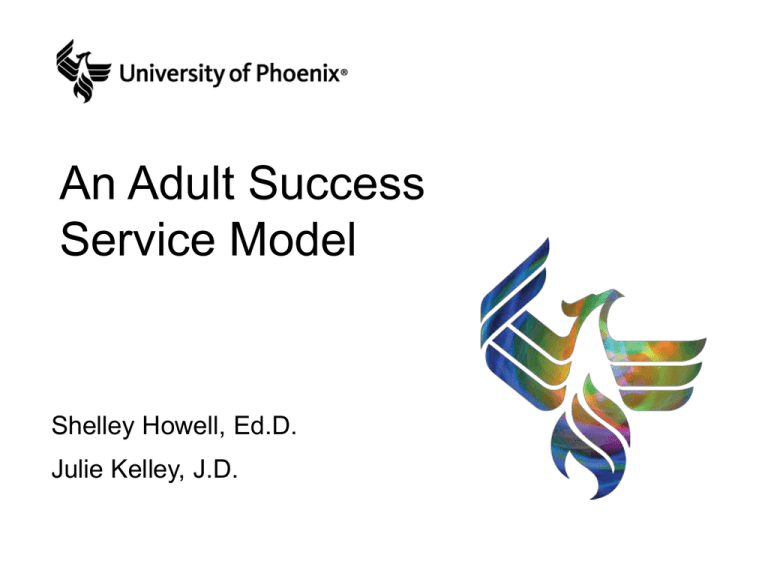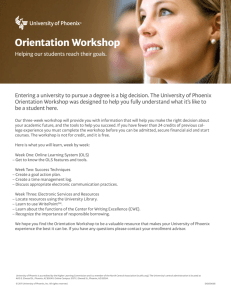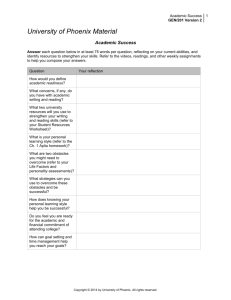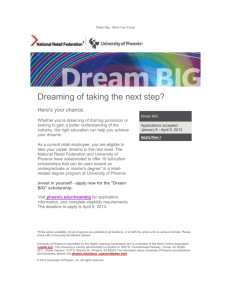
An Adult Success
Service Model
Shelley Howell, Ed.D.
Julie Kelley, J.D.
Agenda
• Brief Overview of University of Phoenix
• Risk Factors and the Non-Traditional Student
• What Adult Students Need and Want from Higher Education
• Creating a Student-Centered Culture
• Career Enhancement Activities
Why We’re Here
537,154 Oklahomans have earned some college
credit but have not completed a degree (Tate, 2009).
(474,747 – per Dr. Applegate, 9/16/2010).
469,212 Oklahomans are living in families whose
combined incomes are less than a living wage (twice the
level of poverty) (Tate, 2009).
Institutions of higher learning must come together
to close this gap and secure a prosperous future
for all Oklahomans.
Who We Are
Mission Statement
The Mission of University of Phoenix is
to provide access to higher education
opportunities that enable students to
develop the knowledge and skills
necessary to achieve their professional
goals, improve the productivity of their
organizations, and provide leadership
and service to their communities.
© 2010 University of Phoenix, Inc. All rights reserved.”
About UOPX
UOPX was founded in 1976 in response to a gradual
shift in higher education demographics from a student
population dominated by youth to one in which
approximately half the students are adults and over 80
percent of whom work full-time.
Accredited by the Higher Learning Commission through
the North Central Association of Colleges and Schools
(NCA) since 1978.
Subsidiary of Apollo Group, Inc.
(Publicly traded under stock symbol APOL)
About UOPX
Over 450,000 current students and 500,000+ graduates
• 21 Associate degree programs
• 44 Bachelor degree programs
• 11 Master degree programs
• 10 Doctorate degree programs
Approximately 25,000 faculty
Programmatic accreditation
• ACBSP (Business)
• CCNE (Nursing)
• CACREP (Counseling)
• TEAC (Teaching)
Campus Locations
Over 200 locations 44 states, District of Columbia, Puerto Rico,
Canada, and The Netherlands
Calgary, AB
Vancouver, BC
Alaska
Seattle
Spokane
Billings
Minneapolis
Portland
Grand
Rapids
Boise
Sioux Falls
Worcester
Milwaukee
Cheyenne
Detroit
Omaha Des Moines
Sacramento
Chicago
Reno
Las Vegas
Denver
St. Louis
Kansas City
Wichita
Colorado Springs
San Jose
Tulsa
So. Cal
Albuquerque
San Diego
Oklahoma City
Tucson
Santa
Teresa
Honolulu
Maui
San Antonio
Baltimore
Louisville
Reston
Raleigh
Charlotte
Columbia
Jackson
Atlanta
Columbus
Dallas
Austin
Wilmington
Cincinnati
Nashville
Memphis
Little
Rock
Phoenix
Jersey City
Philadelphia
Columbus
Indianapolis
Salt Lake City
Boston
Pittsburgh
Cleveland
Guaynabo, PR
New Orleans
Jacksonville
Orlando
Houston
Tampa
Ft Lauderdale
Risk Factors and the
Non-Traditional Student
Risk Factors
The risk factors as identified by the Department of
Education include the following:
• R1 Enrolling part-time
• R2 Delaying entry into postsecondary education after
high school
• R3 Not having a regular high school diploma
• R4 Having children
• R5 Being a single parent
• R6 Being financially independent of parents
• R7 Working full-time while enrolled
(UOPX Annual Report, 2008)
Risk Factors
Increased risk factors are part of what defines non-traditional students. These increased risk
factors – being parents, working full-time, needing class hours that fit schedule, or distance to
campus – are some of the reasons our students cite for enrolling in the University of Phoenix.
Overcoming Barriers
Non-traditional adult students actually need more support
than traditional students.
Day-to-day life issues take precedent over degree
completion.
The more barriers we can remove or help to resolve, the
more likely the student is to reach degree completion.
Educational success of adults in the household is the
greatest indicator of educational success of a child.
© 2010 University of Phoenix, Inc. All rights reserved.”
What Adult Students
Need and Want
from Higher
Education
What Student Do Not Want
Scenario 1: I applied for Financial Aid several weeks ago and I have
been checking back with them repeatedly. All anyone ever tells
me is “It’s in process,” but I get no further explanation. My classes
are starting – I have no money to pay for books – I’m afraid there’s
a problem and I certainly have no way to pay for tuition out of my
pocket if I start. I am frustrated and wonder if it’s really worth it?
Finally, after speaking with five different people for the past five
weeks, I spoke with a financial aid rep who tells me the only thing
that was holding my disbursement was that I had not signed one
institution-specific form and now my funds will be released within
24 hours!
© 2010 University of Phoenix, Inc. All rights reserved.”
What Student Do Not Want
Scenario 2: As a student at state university, my instructors expect me
to turn in all assignments timely, yet some faculty don’t seem to
feel any duty toward me in returning my assignments or providing
feedback to help me improve. I think I am an average student but
have some doubts since it’s been so long since I last attended
college. I’m now in week 12 the semester without a clue whether
I’m making an A or an F.
Why won’t the university hold its faculty accountable to students
regarding grades and feedback? I feel like the university is only
concerned with meeting their needs – it’s not about meeting my
needs.
© 2010 University of Phoenix, Inc. All rights reserved.”
What Student Do Not Want
Scenario 3: I would really love to earn my degree from a state
university. However, I’ve looked at the catalogues and many of
the classes I will need are offered at 4:30 in the afternoon, or it
costs an additional $500 to take anything offered as an online
course. I also hear that the online classes are difficult to
navigate and I have doubts if I could be successful. Some
classes are only offered every other year and will cancel if not
enough enrolled students; some classes are held during a
dedicated two-week block in the summer.
I wonder what other school can meet my needs?
© 2010 University of Phoenix, Inc. All rights reserved.”
What Adult Learners Want from
Higher Education
• Multiple entry, exit, and re-entry points
• Flexibility in course scheduling
• Convenience of location & time
• Accelerated (not abbreviated) curriculum with tailored
choice
• Curriculum focused on job-related content to aid
students in entering or advancing professional careers
• Availability of course materials and support services
United States Dept. of Labor (2007).
Adult Students EXPECT a
Return on Their investment
Do I feel supported by the University?
My advisors contact me regularly.
I am clear on my plan of study and financial status.
I receive a timely response if I have a question or concern.
Am I getting what I am paying for?
Technology is readily available.
Required textbooks are effectively utilized.
The facilities and parking are adequate.
Do I feel supported academically?
Faculty members are available between class sessions.
Academic support is available at the campus.
Electronic learning platforms and resources are adequate.
What our students think is critical.
It is necessary to conduct meaningful surveys
and be responsive to outcomes.
+/- 0%
+ 8%
+ 10%
+ 5%
+ 9%
+ 14%
+ 13%
+ 4%
+ 8%
+ 9%
(UOPX 2009 Academic Annual Report)
Creating A
Student-Centered Culture
Today’s Adult Student
Students who have a good experience in the first few
courses have a better chance of doing well and
remaining at your institution.
They need to feel valued and appreciated for their prior life/work
experience, as well as their current life circumstance.
They need to know where to go for information and that they will
receive consistent, accurate information.
They need instruction which will lead to mastery of the material, as
well as immediately relevant to real-world application.
They need to know they have a voice.
Who is Serving Whom?
Imagine if you had a team built around your individual success.
Imagine if you had a personal relationship with your advisors.
Imagine if every time you walked in and asked for help, you
received those services.
Imagine if you had access to your instructor 7-days-a-week.
Imagine if you had a support network 24-hours-a day.
© 2010 University of Phoenix, Inc. All rights reserved.”
Personal Graduation Team
Student
Support
Network –
Social Media
Student Support
Specialist
Campus College Chairs and Faculty of the Day
Non-Academic Support
Call them first - don’t wait for a problem.
Your students love to hear from you!
Invent an “Early Alert” system for faculty to notify
someone when a student is struggling.
Listen to what your students are saying • About the staff
• About the faculty
• About THEIR experience – not YOUR perceptions
A Network of Support
• Specific connections with staff
Build relationships with graduation team
members
• Faculty Mentors
Build relationships with professionals in the field
• Peer Mentors
Social networking, study groups, shared support
• Community Mentors
Build relationships with others who have gone
before (alumni)
It Begins with Orientation
Today’s student requires engagement.
NSO should be interactive, informative, and
interesting.
Orientation is your first opportunity to set the tone
and make clear that it is about degree completion.
Setting the Right Expectations
Orientation should focus on
Accessibility
Do I have choice in my schedule/campus/modality?
What if I have to take a break?
Affordability
How does financial aid work and how much will I owe?
Am I really going to use all of these expensive books?
Accountability
Do I understand what you expect of me?
Do I understand what can I expect from you?
UNIV/101 & Project Progress
Effective November 1, 2010 – any student entering with less than 24
credits will attend a mandatory three-week orientation workshop.
Students must successfully complete seven tasks or must repeat
UNIV/101 prior to entering credit-bearing course.
The purpose is to assess the student’s personal readiness not academic readiness.
All staff will be evaluated by qualitative measures – not by
quantitative measures.
The goal is not to get them in the door –
it is to get them to the degree.
© 2010 University of Phoenix, Inc. All rights reserved.”
Academic Support
Don’t assume that just because a student
has accumulated 72 or more college
credit hours that he or she has acquired
or retained all the base academic skills to
be successful in core classes.
The gap between date of last attendance
and re-entry date could be significant.
© 2010 University of Phoenix, Inc. All rights reserved.”
Electronic Instructional
Platforms
Electronic learning platforms must be user-friendly.
Faculty must be committed to responding to electronic
postings in a timely fashion.
Electronic course materials should be available at the
students’ fingertips:
• Syllabus and instructor-specific materials
• Textbooks and additional readings
• Academic Support Systems:
Center for Writing Excellence and Center for Math
Excellence
Campus Level Academic Support
Student Support Specialists
Computer basics, use of electronic platforms, student help information
Faculty of the Day
General education course concepts
Writing Support
• Grammar Groomer
• Writing Support (Citation, Thesis/Paragraph Development,
Revision)
Math & Statistics Labs (dedicated to current course students)
Individual Assistance
• Maximum 20 hours per calendar year
• Not to substitute for missed class period
• Assists with course concepts only, not specific homework
Faculty in the Classroom
Whether face-to-face or asynchronous, faculty have the
greatest opportunity to impact a student.
I want to do what is expected of me, but I must be clear on
what is expected of me.
The institution must have written faculty standards concerning syllabi,
feedback, grading criteria, student contact, and classroom conduct.
Support of Faculty:
Initial Training and Continuous Faculty Development
Mentorship
Lead Faculty
Academic Administrative Staff
Peer Relationships
© 2010 University of Phoenix, Inc. All rights reserved.”
Conclusion
The number of bachelor's degrees awarded by public
institutions and private not-for-profit institutions grew by 27
percent between1997/88 and 2007/08.
The number of bachelor's degrees conferred by private forprofit institutions quadrupled during this same period.
(United States Department of Education, 2010).
A partnership between all institutions of higher
learning is needed to better serve our students,
ultimately serving the State of Oklahoma by
increasing the number of college graduates.
Questions?
University of Phoenix –
“Reinventing education . . . again.”
© 2010 University of Phoenix, Inc. All rights reserved.”






